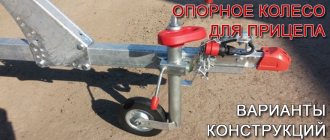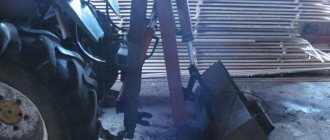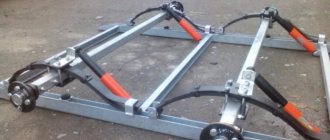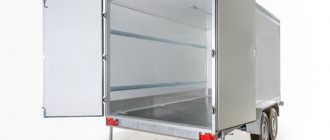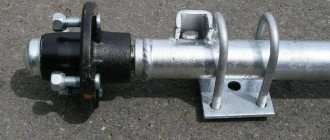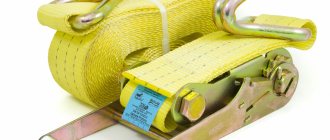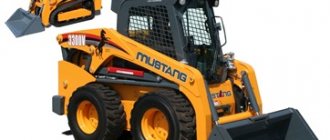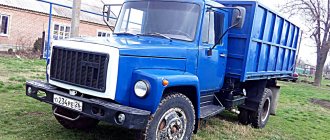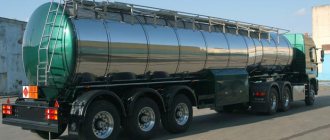Support leg on the drawbar of a trailer for a passenger car. What do you need to know about the support leg of a trailer for a passenger car? Is a support leg required on a trailer? How are the support legs different? How to choose a support leg? What is the difference between support leg clamps? How to avoid losing the support leg while the trailer is moving? This information will be useful primarily to those who are just planning to buy a trailer or have recently bought their first trailer.
What do you need to know about the trailer support leg?
Most often, the support leg is a screw jack combined with a rolling wheel. It is installed on the trailer drawbar. Serves for the convenience of coupling the trailer to the car and for holding the uncoupled trailer in a horizontal position. The trailer with support leg can be easily moved horizontally by one person.
Trailer with support leg can be easily moved by one person
There are also legs designed to stabilize the trailer. These legs do not have a rolling wheel. They are trimmed with a “nickel” at the bottom. Installed on the sides at the rear of the trailer. They are a pipe with a handle on top. Sometimes called a support post.
Trailer with support legs
Less commonly installed at the four corners of the trailer platform. In this case, they can be screw jacks for hanging the trailer platform.
The trailer platform is hung on screw racks
Is a support leg required on a trailer?
This is, of course, up to the trailer owner to decide. Most trailers today are sold without a support leg. This is due to the fact that almost all manufacturers do not equip their trailers with a support leg as standard. It would seem, why? After all, this is a very convenient and useful option. The answer is obvious. In order to reduce the cost of the trailer. In this case, the support leg can be purchased immediately when purchasing the trailer. Or do it later at any trailer store. Initially, trailers produced by TRAILER and TAVIALS are equipped with support legs.
Support leg on a single axle trailer
If the trailer is small, say, with the internal dimensions of the platform one and a half meters by meter, then you can do without a support leg. This trailer doesn't weigh much. And he usually doesn’t take much load. You can handle it quite easily even without a support leg. However, having unhooked the trailer from the car, you will have to lower the drawbar down, tilting the trailer. And this is not always convenient, especially if the trailer is loaded. If the trailer has a medium-sized platform, say 2.5 meters by 1.2 meters, then it will be much more comfortable with a support leg. Firstly, when hooking (or unhooking) the trailer to the car, the coupling head is at such a height that you need to bend over. Even for a short person. Without a supporting leg, the entire load falls on the spine. Secondly, a trailer with a support leg has a movable third point of support. Thus, uncoupled from the vehicle, it is in a horizontal position and can be easily moved over short distances by one person.
Support leg on a two-axle trailer
Two Axle Trailer with Support Leg
Is a support leg required on a two axle trailer? The two-axle trailer stands perfectly on its two axles and without a support leg. Even loaded. Almost perfectly horizontal. The key word here is practically. And if the coupling head is slightly higher than the towbar ball, then to hook the trailer to the towbar you just need to jump on the drawbar. If the coupling head is lower than the ball, then without a support leg you will have to lift it with your hands. Again, tilted, because squatting is not comfortable. Closely.
There is another reason why a support leg on a tandem axle trailer will be very useful. Try to turn the two-axle trailer uncoupled from the vehicle in place. Even with two people this is quite problematic. And if the trailer is loaded, then even more so. One of the axes will skid. It would seem, why do you need to turn a two-axle trailer by hand? Try to drive the ball of the tow bar under the hitch head of the trailer. It is difficult to do this perfectly accurately, even with a rear view camera. As a result, in order to hook the trailer to the towbar, you often have to move the trailer not only forward (or backward), but also to the side. Sometimes you just need to roll the trailer from one place to another. However, not always in a straight line. It is possible that the trailer simply needs to be turned by hand and unhooked from the vehicle. After all, in a limited space it is not always possible to turn around in a car with a trailer.
So how do you turn a two-axle trailer around? There are two ways to do this. In both options, you need to hang one of the axes. On an empty trailer, you can load the drawbar by hanging the rear axle. In this case, the weight of the average person will be quite enough. You can press the drawbar, for example, with your foot. At the same time, we turn the trailer around with our hands, holding the front side. If there is a support leg on the trailer, first raise it as much as possible and fix it. It is advisable to turn the trailer in the opposite direction from you. If the trailer is loaded, it is much more convenient to hang the front axle. To do this, raise the trailer drawbar with the support leg. Raise until the front axle hangs in the air. As a result, the trailer remains on three points of support: the two rear wheels of the trailer and the wheel of the support leg. In this form, the trailer can be operated by one person.
How are the support legs different?
Support legs are produced by a fairly large number of enterprises. Naturally, they all use different materials in the production of support legs. In addition to the materials from which the support legs are made, they differ in size, handle shape, rolling wheel, strength, load capacity, and mounting clamp.
The most common leg has an outer pipe diameter of 48mm. Support legs with a diameter of 42mm, 57mm, 60mm are also available. Large diameters are found on large and heavy trailers, as well as on car transporters.
Support legs tavials with different outer pipe diameters
The large diameter of the outer cylinder of the support leg is found on large and heavy trailers and car transporters
From left to right: support leg with reinforced wheel, support leg with dynamometer, standard support leg with riveted and plastic disc
Support leg AL-KO, Chinese support leg, support leg “automatic” from the Kurgan trailers company
For all its absurdity, the so-called “automatic” support leg of the Kurgan trailers enterprise is very functional. It can be used to move a trailer unhooked from the vehicle. It can be used as a stopper by lifting the wheel and placing the leg on the “penny”. In the transport position, the wheel rises up. At the same time, the ground clearance under the trailer drawbar is practically not reduced.
Support leg “automatic”, Kurgan trailers enterprises
An AL-KO wheel with a locking element can also be used as a stopper. Wheel chocks, of course, are unlikely to replace such a stopper, but they will hold the trailer on a minimal slope or in a gust of wind.
Support leg with stopper
A recessed flag blocks rotation of the support wheel, a raised flag allows the support wheel to rotate.
“Flag” blocking the rotation of the support wheel
An inflatable (“Blown”) wheel is more often used with trailers for transporting water equipment and with trailers used mainly on rough terrain. On asphalt it is not very relevant.
Support leg with an inflatable wheel: with a paired wheel, on a plastic disk, on a riveted disk, on a welded disk.
Recommendations for selection
The structure can be installed on any type of trailer. Therefore, if you have MZSA or Krepysh, for example, it is easy to supplement them with such a system. And for a boat trailer, a dolly wheel will only be beneficial.
But you still need to choose the right device. You need to rely on several basic parameters:
- type of construction;
- load capacity parameters;
- type of tire;
- disk version, etc.
I suggest going through the points separately. This will allow you to understand what types of support wheels there are, what the difference is between them and which one should be preferred specifically in your case.
Removable or foldable
Start with this. Removable devices are installed on the support leg when it is necessary to fix the vehicle in one place and move it as necessary.
There are also foldable designs. Here, when lowering the trailer, the stand with the wheel in automatic mode is installed in its working position. When the vehicle is connected to the car’s towbar, the entire structure folds under the drawbar and does not interfere with further operation at all.
On some rolling devices, the function of adjusting the height of the support leg is available.
Automatic or manual
What is the difference between support leg clamps?
If we talk about the fundamental differences, then these are crimp and rotary clamps. These clamps have different principles of use.
AL-KO swivel and crimp clamps
In the rotary clamp, the support leg is clamped permanently. In the transport position, the leg is positioned horizontally on the drawbar. By pulling back the spring-loaded locking bracket, the leg rotates to the working (vertical) position.
Support leg with swivel clamp in transport position
The crimp clamps have a pressure screw with a handle for ease of use.
Crimp clamps for support legs. From left to right: AL-KO clamp, Chinese without name, Kurgan trailers
Despite the external differences, they have the same operating principle. By releasing the clamping screw, you can place the leg at any height. In the transport position, the leg rises as high as possible.
Trailer TAVIALS A2515 with support leg in transport position
How to choose a support leg?
When choosing a support leg, the main thing you need to pay attention to is the outer diameter of the leg. It must match the clamp with which it will be used. And of course, pay attention to the quality of the materials from which it is made. In my opinion, the most reliable support legs are those made by AL-KO. As practice has shown, they are the strongest and most durable. They have a fairly thick-walled outer tube and powerful plates on which the idler wheel is mounted. It's almost impossible to bend them. Even on purpose. The wheel itself also inspires confidence and, if handled correctly, will last a long time. This leg costs more than others, but will also last much longer. Of course, provided that it is handled correctly.
Review of Eurodetal car boxes: characteristics, owner reviews
Load capacity
Based only on photos and videos, it is impossible to say exactly what load the device is designed for. And in terms of carrying capacity, they can differ significantly. This figure varies from 150 to 500 kilograms for passenger trailers.
If you have a small trailer up to 750 kg, then it is enough to take a support with a vertical load parameter of up to 150 kg. When the total vehicle weight is 1-2.5 tons, the support wheel is selected at 300 kg. Already in the case of cargo trailers, a load capacity of 800 to 1500 kg is required.
Additionally, I advise you to pay attention to the support bearing in the handle of the support wheel. If there is one, it will simplify and extend the life of the device.
Tires and wheels
Rubber can be solid or pneumatic. Pneumatic tires have smoother driving characteristics. But this advantage hides the need for careful maintenance of the structure. Therefore, think for yourself what is your priority.
As for disks, they come in plastic and steel. There is no particular difference in operating conditions between them. They both can withstand the load for which they were designed. Although for some, the disc material may play a role in the choice.
If we talk about manufacturers, then I can’t give specific recommendations. Each one has its own characteristics and requirements. Plus, everyone has different financial capabilities.
Let me just say that buying cheap devices makes no sense. They wear out quickly and cause more trouble than they are useful. The running wheels are from Winterhoff, Al-Ko, SPP and Knott. These are all European companies that have proven themselves well in the Russian market.
That's all. Thank you very much for your attention! I hope I was able to help you in choosing a support wheel, and you will be able to find the right option for your caravan. If you have questions, ask in the comments. We will try to answer quickly.
Don't forget to subscribe and tell your friends about our site! It will also be useful and interesting for them to know.
How to avoid losing the support leg while the trailer is moving?
The support leg has two positions. Work and transport. During movement, the support leg is in the transport position. If a rotary clamp is installed on the drawbar, then losing a leg is practically impossible. The swivel clamp is securely fixed in a horizontal position. In this case, rotation of the handle is impossible. The drawbar will interfere with her. As a result, nothing will unwind, get out of place, or get lost.
With a crimp clamp, in order not to lose the leg, you will have to meet a number of conditions. When the trip is not long, it is enough to raise the support leg as much as possible, securely fix it with a clamp and tighten the screw jack handle tightly. The handle has no stopper. It is held in place only by friction. If you don't tighten it tightly enough, it may start to vibrate. In this case, the wheel will sink lower and lower. And until it falls out or encounters any obstacle. Let's say a speed bump. If you hit an obstacle, the outer cylinder of the support leg, the wheel plates, the wheel disc may become jammed, and the clamp may bend. To prevent this from happening, it is enough to deprive the handle of the support leg from rotating. This can be done, for example, using a regular elastic band. Hook one end of the elastic band to the handle, the other to any part on the trailer.
When you have to travel a long distance, it is better to remove the leg completely. This can be done by completely unscrewing the clamping screw. After removing the leg, install the clamping screw in place. It would also be a good idea to lubricate its threads with any grease.
How to make a do-it-yourself wheel for a light trailer
To make it, you will need the following:
- An old jack for a Lada or something similar.
- A wheel that will be attached to the bottom. It can be purchased at the appropriate store.
- A metal plate will be needed.
- Bolts for fastening.
- Primer and paint will be required.
- You need a drill and drill bits of the appropriate size.
- Welding machine.
- Brushes for painting structures.
Made by yourself
You will need to do the following:
- Holes are made in the plate and in the drawbar for bolts that will hold them together.
- A metal plate needs to be welded to the jack. It should be located in a vertical plane and attached to the top of the jack.
- A wheel is welded to the bottom.
- The finished structure is primed and painted in order to protect it from environmental influences.
- Now the structure is bolted to the trailer drawbar. It is possible to make this connection by welding, but in this case the structure cannot be removed.
Now the homemade structure is installed and ready to go.
Useful tips
When making it, it makes sense to pay attention to the following:
- Since the structure will be outdoors for a long time, it must be protected from the influence of bad weather. To do this, it will need to be painted.
- The wheel is welded to a metal base, which was used as a support when working with the jack.
- Although you can purchase a small wheel, it is nevertheless better to purchase a more powerful one that is more convenient for movement.
When folded
